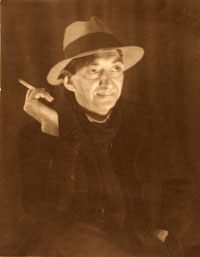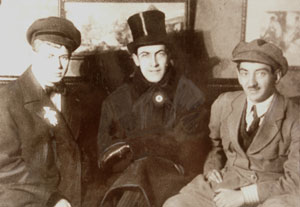|

|
Georgii
Bogdanovich Yakoulian (Yakoulov) was born in Tiflis on January
2nd 1884 and died in Erevan, Armenia, on December 28th 1928. A
painter, graphic artist and set designer, he lived in Moscow
from 1893 becoming a leading member of the early Soviet avant
garde.
In 1900-02 he studied at the Moscow
Institute of Painting, Sculpture and Architecture where his
teacher was the artist and set designer, Konstantin Yuon. He
was dismissed from the College in 1903 for rebellious behavior
and was immediately called up for military service on the
Russo-Japanese front. During his time in the East,
particularly in Manchuria, he began to develop his theory of
light. In later years this may have been an influence on
Robert and Sonia Delaunay whose theory of Simultanism has much
in
common with Yakoulov's ideas.
|
|
 |
Yakoulov's prize winning model of
the Monument to the Twenty-Six Commissars of Bakou
presented at the International Exhibition in Paris 1925. |
 |
Yakoulov (right) with his close friends
the writers Sergei Esenin and Anatolii Mariengof. |
Photographs are from
the private collection of Mary Sarkassian entrusted to Lesley-Anne
Sayers in 2001.
|
In
1917 Yakoulov designed the interior of the Cafe Pittoresque
in Moscow assisted by Alexander Rodchenkoand Vladimir Tatlin. This is thought to have been the
first time three dimensional non-utilitarian constructions were
used to create a total environment. Movement,
light and theatrical dynamism were at the heart of his approach
to both painting and stage design. He is particularly renowned
for his designs for Alexander Tairov's Kamerny Theatre
productions in Moscow, but he also collaborated with Meyerhold
and other directors.
Yakoulov was an active force in the transformation of Russian theatre post 1917. He embraced the
notion of theatre as an active educational force for change that sought to reach and involve the Soviet peoples
by drawing on forms from popular entertainment, such as circus, vaudeville and
cabaret. But above all Yakoulov was committed to a dynamic conception
of theatre as interactive, anti-naturalistic and performance based.
Unlike many of his contemporaries, Yakoulov
never abandoned easel painting, and remained an eclectic
artist with a love of both bohemian and revolutionary ideals. His
work draws on several artistic movements, principally Futurism, Cubism and Constructivism.
His paintings were exhibited
internationally, alongside leading artists of the day, but he
was best known for his theatre designs which were highly
influential in both Moscow and Paris.
Yakoulov worked also for the theatre in
Yerevan, in his beloved Armenia, where he died of pneumonia aged
44. On his death most of his paintings were left in
Paris - some in the care of Larionov. It was not until the 1970s,
through the research and efforts of museum curator Mary
Sarkassian, that
his work was to return to the former Soviet Union. The major
collection of his paintings is held by the National
Gallery of Yerevan in Armenia.
Lesley-Anne Sayers, 2004.
|